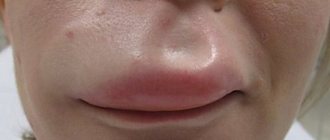Trivalent arsenic (As+3) binds to the thiol groups of enzymes and other proteins in tissues. When taken orally, it causes enterotoxic, neurotoxic, hemolytic effects and associated kidney and liver damage. In chronic poisoning, arsenic usually accumulates in hair and nails.
Arsenic and its compounds (arsenic anhydride, arsenous acid and its salts, arsenous hydrogen, salvarsan, osarsol, herbicides, “Paris greens”, pesticides) are used to treat seeds, leather, fur, and destroy garden pests.
Arsenic, entering the body through inhalation, being absorbed from the gastrointestinal tract and from the surface of the skin, causes acute or chronic poisoning. Chronic forms of intoxication are more often observed, usually in the form of sensory or mixed forms of polyneuropathy.
Symptoms of poisoning
Symptoms of arsenic poisoning make themselves felt within half an hour after oral ingestion of the toxic substance into the body. When poison enters the respiratory tract, intoxication manifests itself almost instantly.
The symptoms are similar to classic chemical intoxication of the body: general weakness, abdominal pain, headache, diarrhea, nausea and vomiting. A characteristic smell of garlic is heard from the mouth, the skin becomes dry, diuresis decreases, tachycardia and thirst appear, and blood pressure decreases.
If the victim is not provided timely first aid, the poisoning worsens and leads to damage to various organs. Arrhythmia, convulsions, and pulmonary edema develop. All this can be accompanied by internal bleeding, which is very life-threatening. In addition, the skin becomes yellow and the urine turns dark. In some cases, the victim develops kidney failure.
With chronic poisoning, the first signs appear over a longer period. During this time, arsenic affects nerve tissue and leads to the development of conditions such as encephalopathy and neuropathy.
Against this background, a person experiences pain in the limbs, the sensitivity of the skin is impaired, as well as the functioning of the heart, and pericarditis or myocarditis develops. In some cases, the manifestation of chronic poisoning will be a toxic form of hepatitis, bronchitis, laryngitis, anemia, tracheitis. This poison is a carcinogen, so chronic exposure may lead to the development of skin and lung tumors. Arsenic is also associated with adverse pregnancy outcomes and neonatal mortality, and exposure in utero and early life is associated with increased mortality among young people due to various cancers, lung diseases, heart attacks, and kidney failure. Numerous studies have demonstrated the negative effects of arsenic exposure on mental development , level of intelligence and memory.
Sources of influence
Arsenic is a naturally occurring element in the earth's crust and is widely distributed in the environment - in air, water and soil.
Its inorganic form is highly toxic. People are exposed to elevated concentrations of inorganic arsenic through contaminated drinking water, by using contaminated water for cooking and irrigating food crops, during industrial processes, and by eating contaminated foods and smoking tobacco.
Long-term exposure to arsenic in drinking water and food can lead to chronic arsenic poisoning. The most common consequences are skin lesions and skin cancer.
Drinking water and food
The greatest threat to human health is arsenic contained in groundwater. Inorganic arsenic occurs naturally in high concentrations in groundwater in a number of countries, including Argentina, Bangladesh, India, China, Mexico, the United States of America and Chile. Sources of exposure include drinking water, food crops irrigated with contaminated water, and food prepared with contaminated water.
Fish, shellfish, meat, poultry, dairy and grain products can also be dietary sources of arsenic, although the level of exposure to arsenic contained in such foods is generally much lower than the level of exposure to contaminated groundwater. In marine products, arsenic is mainly found in its less toxic organic form.
Industrial processes
Arsenic is used industrially as an alloying additive and in glass, dyes, textiles, paper, metal adhesives, wood preservatives, and ammunition production processes. Arsenic is also used in tanning processes and, to a limited extent, in the production of pesticides, feed additives and pharmaceuticals.
Tobacco
People who smoke tobacco may also be exposed to naturally occurring inorganic arsenic in tobacco because tobacco plants absorb a significant amount of arsenic naturally present in soil. In the past, levels of potential arsenic exposure were much higher because tobacco plants were commonly treated with an insecticide containing lead arsenate.
First aid for poisoning
If you suspect arsenic poisoning through the mouth, you should immediately drink a glass of warm water in which three grams of citric acid or one tablespoon of vinegar is diluted.
It is recommended to drink plenty of fluids (the procedure helps not only to quickly remove the poison along with urine, but also fights dehydration of the body caused by vomiting and diarrhea); In no case should you fight vomiting and diarrhea; on the contrary, you need to promote the natural cleansing of the body by drinking warm milk. Taking adsorbents is not a very effective procedure, but in the absence of other means it helps to slightly reduce the dose of poison in the body. If arsenic gets on the skin, it is enough wash the body with warm water and soap, preventing the poison from being absorbed into the blood.
It is important to understand that in case of arsenic poisoning, emergency medical attention is needed. Toxicologists treat arsenic intoxication in the body.
Before treatment, laboratory tests are prescribed. Urine and blood tests can determine the amount of arsenic in the body. It is worth noting that in urine it should not exceed 100 mcg per 1 liter of urine, and in blood 30 mcg per 1 liter. There is also decreased hemoglobin and red blood cells in the blood, increased ESR, and increased protein levels in the urine.
After a few months, arsenic can be easily detected in the victim's hair and nails. There are special drugs that act as an antidote and are administered intramuscularly in a hospital setting; antidote and symptomatic therapy is also performed, and, if necessary, urgent resuscitation measures.
Best materials of the month
- Coronaviruses: SARS-CoV-2 (COVID-19)
- Antibiotics for the prevention and treatment of COVID-19: how effective are they?
- The most common "office" diseases
- Does vodka kill coronavirus?
- How to stay alive on our roads?
Scale of the problem
Arsenic contamination of groundwater is widespread, and a number of areas have significant levels of arsenic contamination in drinking water. Today, at least 140 million people in 50 countries are known to drink water with arsenic concentrations above the WHO guideline level of 10 µg/liter (4).
After in the 1990s. In Bangladesh, widespread arsenic was found in well water, and the issue of arsenic exposure in that country has received a lot of attention. Since then, significant progress has been made, and the number of people exposed to arsenic levels above the Bangladesh Drinking Water Quality Standard has decreased by approximately 40%. Despite these efforts, it is estimated that in 2012, approximately 19 million and 39 million people in Bangladesh were exposed to arsenic levels above the national standard of 50 μg/liter and the WHO guideline of 10 μg/liter, respectively (5 ). In areas of Bangladesh where the problem is particularly acute, 21.4% of all deaths were caused by arsenic concentrations in drinking water greater than 10 µg/liter (6). A similar dose-response relationship was observed in other parts of Bangladesh: these results were combined with those of a national survey, and the combined analysis yielded an annual arsenic-related mortality rate of 43,000 (7). The US National Research Council has noted that lifetime consumption of drinking water containing 50 µg/liter arsenic (8) may be responsible for up to 1 in 100 additional cancer deaths.
Symptoms and signs caused by long-term exposure to elevated concentrations of inorganic arsenic vary between individuals, populations, and geographic areas. Therefore, there is no general definition of the disease caused by arsenic. This makes it difficult to estimate the burden of disease associated with arsenic.
There is also no method for distinguishing between cancers caused by arsenic and cancers caused by other factors. As a result, there is no reliable estimate of the extent of the problem worldwide.
In 2010, the Joint FAO/WHO Expert Committee on Food Additives (JECFA) re-evaluated the health effects of arsenic exposure in the light of new evidence. JECFA concluded that for selected areas of the world where levels of inorganic arsenic in drinking water exceed 50-100 µg/litre, there is some evidence of adverse effects. For other areas where elevated levels of arsenic in water (10-50 µg/litre) are observed, the committee noted that while adverse effects may occur, the prevalence is low and would be difficult to detect in epidemiological studies.
Prevention and control
The first action for affected regions is to prevent further exposure to arsenic by ensuring safe water supplies for drinking, cooking, and irrigating food crops. There are a number of ways to reduce arsenic levels in drinking water.
- Replacing sources with high concentrations of arsenic, such as groundwater, with microbiologically safe sources with low concentrations of arsenic, such as rainwater and treated surface water. Water with a low concentration of arsenic can be used for drinking, cooking and irrigation, while water with a high concentration of arsenic can be used for other purposes, such as washing and washing clothes.
- Distinguishing between sources with high and low arsenic concentrations. For example, you can test water for arsenic levels and paint wells or hand pumps with different colors. When combined with effective health education, this can be an effective and inexpensive intervention to quickly reduce arsenic exposure.
- Mixing water with low and high concentrations of arsenic to achieve acceptable arsenic levels.
- Install arsenic removal systems—centralized or individual—and ensure proper disposal of removed arsenic. Technologies for arsenic removal include: oxidation, coagulation-precipitation, absorption, ion exchange and membrane technologies. There are a growing number of effective and low-cost options for eliminating arsenic from small and domestic water supplies, although there is still limited data on the extent to which such systems are used effectively over sustained periods of time.
Long-term interventions are needed to reduce workplace exposure to arsenic during manufacturing processes.
Health education and community involvement are key to ensuring successful interventions. It is important that community members understand the dangers of exposure to high concentrations of arsenic and know the sources of arsenic exposure, including arsenic contamination of food crops (eg, rice) from irrigation water and arsenic contamination of food from cooking water.
Monitoring of high-risk groups should also be conducted to detect early signs of arsenic poisoning, usually skin problems.
Metabolism of arsenic in the human body
Arsenic (mineral)
The absorption of arsenic is directly related to its dispersity, i.e. large particles of arsenic pass through the body with virtually no consequences. Once absorbed, arsenic accumulates in the kidneys, liver, lungs and heart muscle. Arsenic begins to accumulate in hair 2 weeks after the interaction begins, and can remain there for several years.
Arsenic has a certain chemical similarity to phosphorus, so traces of it can be found in teeth and bone tissue for a long time.
Arsenic compounds easily penetrate the placental barrier and affect the embryo.
The body tries to get rid of an overdose of arsenic in all possible ways - the substance is excreted in feces, urine, through the skin and lungs, and is deposited in falling hair.
Arsenic poisoning affects the functioning of all organs.
Diagnostics
The clinical picture of the pathological process is usually well defined, so there are no problems with making a diagnosis. After the person’s condition has been stabilized, the following diagnostic measures are carried out:
- general and biochemical blood test;
- general urine analysis;
- Ultrasound of internal organs;
- endoscopic examination of the gastrointestinal tract;
- chest x-ray.
The above diagnostic program is exemplary. Doctor's prescriptions are made on an individual basis, depending on the patient's condition and the severity of the poisoning.











